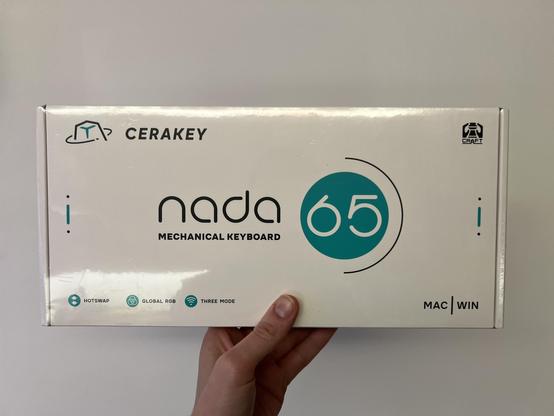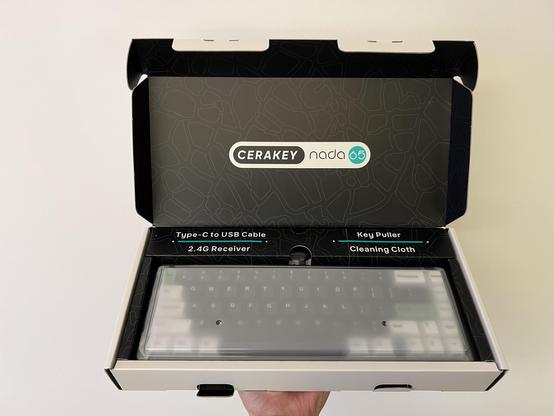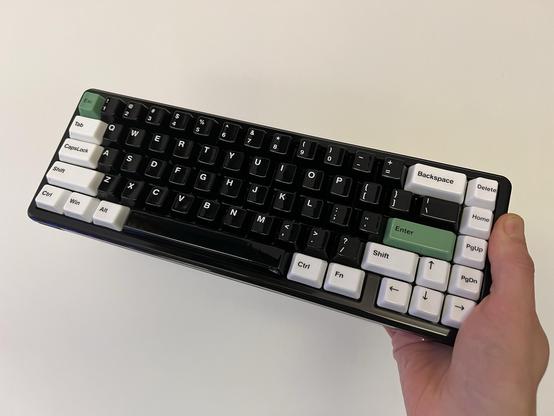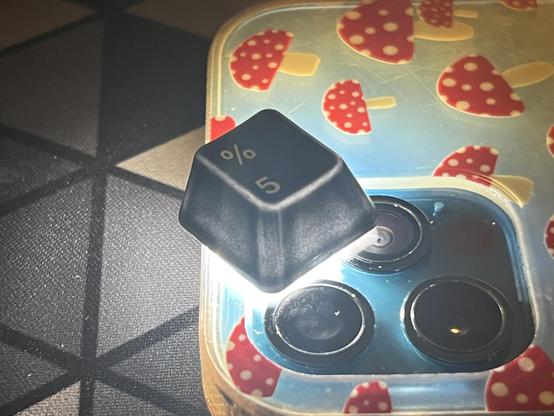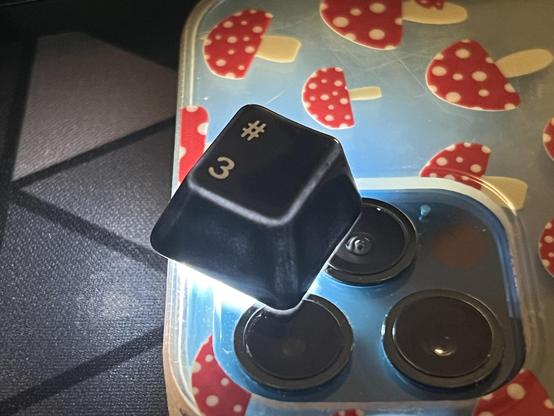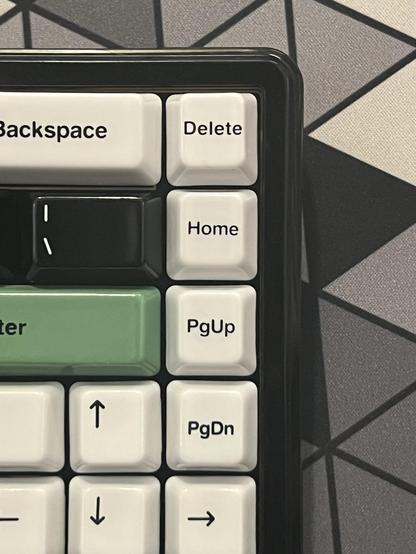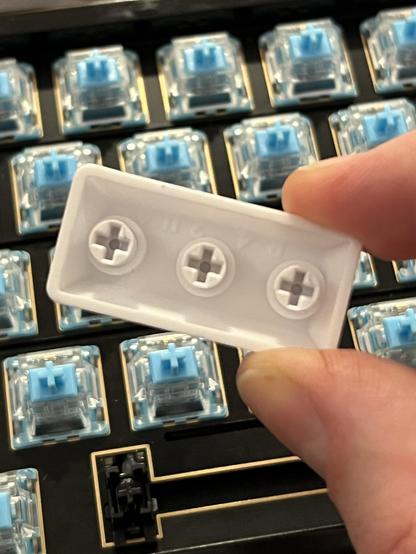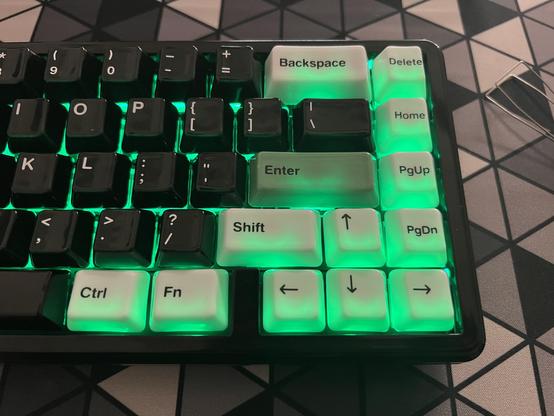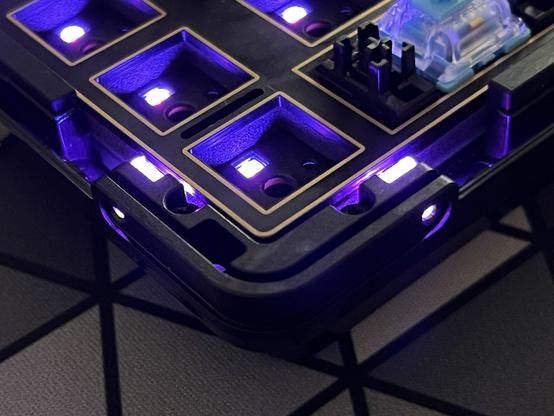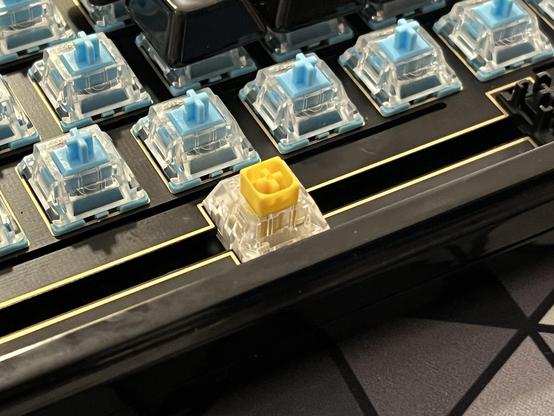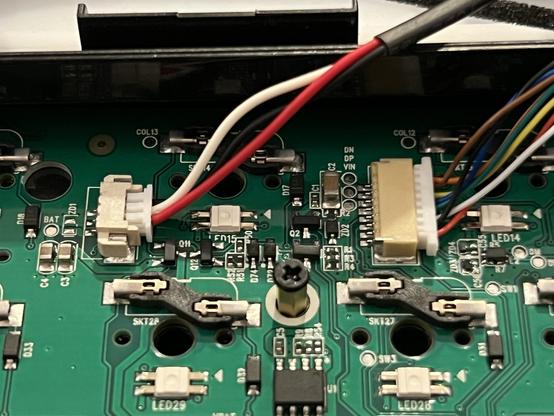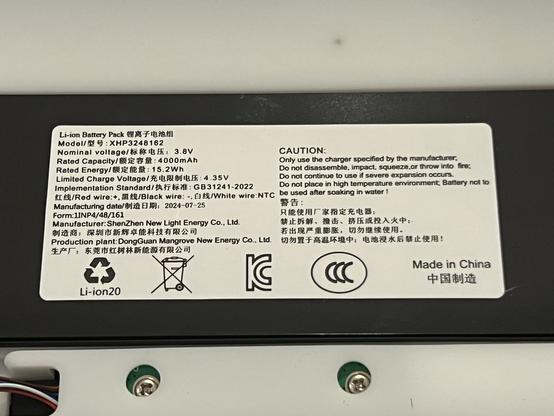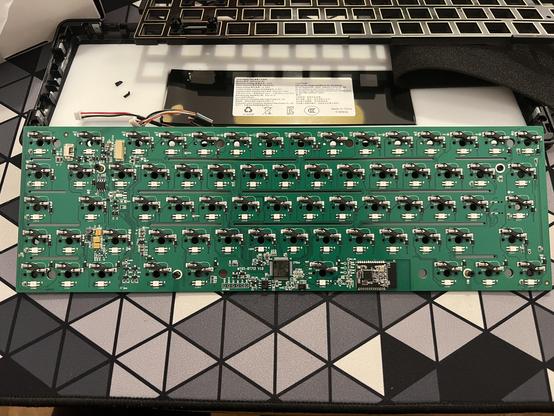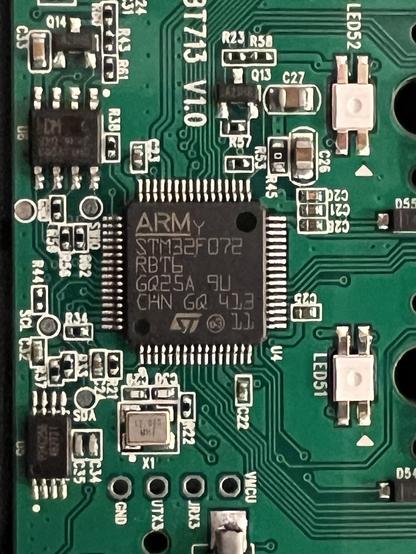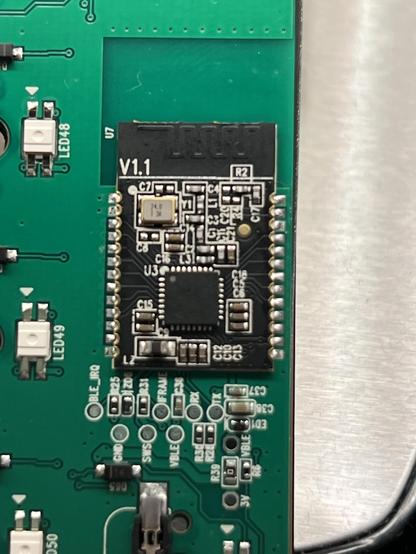Cerakey Nada 65 Mechanical Keyboard Reviewed
Cerakey have been one of my bucket-list mechanical keyboard brands since I started writing about them. It’s easy to see why – the allure of thocky ceramic keycaps is strong and Cerakey have some great looking sets that promise the durability (and sheer novelty) of ceramic with the convenience of a regular, MX style keycap mounting stem.
A wild keyboard appears!
The Cerakey Nada 65 is a showcase for their ceramic keycaps.
The concept, at first, seems improbable but somehow Cerakey manage to fuse an MX-style plastic mounting stem into their ceramic caps making them compatible with most (with exceptions for alternate keycap mounting systems) mechanical keyboards. This best of both worlds approach makes for a durable keycap with a straightforwardly familiar mounting system, they pop off and push back on just like any other caps.
It’s a thocky boi!
Cerakey were gracious enough to supply their Nada 65 keyboard for review, showcasing both their ceramic keycaps and their 65% keyboard offering.
The Caps! We all wanna know about the caps!
Right out of the box the Cerakey ceramic caps were icy cold to the touch – it clearly got cold in transit – and very noticeably different from plastic. A cold office – like mine – might not be the best place for such a board. It’s a little like typing on cold metal and they never quite seem to warm up fully. I guess our house is cold!
The caps have imperfections in their surface as you would expect from fired, glazed ceramic. Rippling runs both left to right and top to bottom with each cap catching the light in a slightly different way. The overall effect is remarkably different from the normally smooth or coarse textured finish of a plastic cap. It feels a little more organic, natural if you will, and it’s nice.
Upon further inspection the glaze is- as you might guess- thinner at the very edges. This lets a small amount of light bleed through with the backlight turned up. It’s much easier to see with a bright mobile phone torch though!
The glaze is somewhat uneven, though this isn’t visible to the naked eye. It’s quite impressive just how deep gloss black the black keycaps are, yet they still bleed some backlight through the top edges at high brightness. It’s so subtle it feels like a trick of the eye, but I sat a couple of caps on top of a very bright phone torch to confirm I wasn’t seeing things.
If Cerakey could control the glazing process with more finesse, or come up with some form of glaze resist for a double shot glazing process, shine-through legends on ceramic caps would be magical.
The curse of the legends strikes again- one font weight and size across all of these keys would be nice!
As it stands, the legends seem to be printed under, on or in the glaze somehow, and – particularly on larger keys with more lettering – feel slightly rough to the touch. They are, however, very crisp and clear with no obvious bleed or inconsistency in the lettering on any individual key – even if font weight and size across keys like Delete, Home, PgUp and PgDn is all over the place. That the legends on *ceramic* keycaps look this good is quite something, though I would prefer fewer words and more icons- or just blanks!
The plastic stems are fused into the ceramic using dark magic or something. The underside of these keycaps is super clean!
The underside of each cap is relatively unremarkable. Where plastic might be blobby from double shot moulding, the ceramic is a pure white with a little recess for the plastic stem. It’s clear that all the colour comes from the glaze, which is – in effect – a kind of double shot process. The surface of the ceramic itself is dull and rough, most easily felt around the bottom edge of a keycap where the glaze – presumably applied from above – doesn’t cover.
Aside from the look and feel, Cerakey’s ceramic caps have some other things going for them. Most notably ceramic’s durability. You’re trading toughness for hardness and a glazed finish which is unlikely to ever dull or fade- after all ceramic is usually the material of choice for plating up food, and that sees much worse than some grubby fingers. Last, but certainly not least, is the sound. It’s safe to say that the Nada 65 THOCKS (For the uninitiated, that’s an onomatopoeia for a pleasant, low-frequency typing sound). It’s a great little board to effortlessly soak up misdirected hate for open plan offices. A sure fire way to slowly undo your colleagues last threads of sanity in style.
The Board
With the backlight at full brightness it shines through both the white keycaps and the very edges of the black keycaps. It looks almost like a trick of the eye in the case of the latter. These caps are so very, very dark gloss black!
The Nada 65 is competent as a showcase for Cerakey’s caps, but it isn’t a great deal more than that- being a pretty run of the mill, entry level tri-mode board. It’s a lightweight and plastic with lots of give and flex, some chunky rubber feet and not one but three panda-themed badges underneath. The gloss black plastic matches the ceramic black and white caps well, though, and the board mostly gets out of the way and lets the keycaps shine. Sometimes literally- since the RGB underlighting will actually shine through the white glazed keycaps.
The side lights peek through metal L-shaped corner pieces which are screwed into the base.
The keyboard also has some little pin-prick LEDs at the corners. Eight in total with two each on each corner, accenting a recessed corner detail. Suffice to say, setting the backlight to a fixed green works well and leans into the natural theme of the board.
The back of the board has a USB Type-C port – as it should – and switches for picking macOS / Windows layouts (though there are no alternate macOS keycaps there’s a panda-themed novelty you can use in lieu of Win) and Tri-mode select (USB, 2.4GHz and Bluetooth). The switches are unlabelled but it’s clear that one is two-position and one is three so at least they’re easy to tell apart. Bluetooth mode is the right-most position (with the keyboard facing toward you) and 2.4GHz the leftmost. Bluetooth pairing is the usual affair, with Fn + Q, W or E allowing access to three paired devices. The keyboard shows up as “BT5.0 KB.” On Bluetooth you’ll miss a few keys as the keyboard wakes up from sleep, I usually get into the habit of tapping some arrow keys to solve this – at least Cerakeys ceramic keys are a joy to tap!
The Software
I’m almost exhausted from repeating myself, but the Nada 65 is another QMK/VIA board that requires side-loading a .json file in order to use VIA to remap it. If these words mean nothing to you, you’re probably fine- remapping, macros and other such features are either something you use and are intimately familiar with already, or something you can live without and ignore. In my case I occasionally remap one or two keys for convenience, but the Nada 65 is good to go out of the box.
Cerakey dial up the frustration a little more by supplying their JSON file as a .rar archive… please, Cerakey, just let us download the json or use .zip. macOS has no native support for rar, and I had to install The Unarchiver to… unarchive it. (sidenote, is Stuffit Expander still a thing? Ah, I’m old.) Thankfully this is balanced slightly since these are v3 VIA definitions, so you don’t need to flip that little “Use V2 Definitions” switch to use them. If you’re planning to grab a Nada 65 then I’ve stuck the JSON on GitHub here.
The VIA JSON identifies the Nada 65 as “HyphaRF KB351” with a VID of 0x1480, which is SITEK S.p.a. A little sleuthing couldn’t identify the origins of this board from these mystical strings but it’s worth noting that Cerakey are a Keycap company and not a Keyboard company so it makes sense that they’d have a third party handle this.
The 2.4Ghz dongle identifies itself as NADA65, while the USB connection simply as “Gaming Keyboard.” Sadly VIA cannot be used via 2.4Ghz so you need a wired connection in order to configure mappings.
Thankfully the board uses Layers 0 and 1 for Windows and associated Fn keys, and layers 2 and 3 for macOS. Don’t forget this, since it trips up beginners. If the little switch on the back is on the left (with the board facing toward you and the back facing away) then it’s in Windows mode, if it’s on the right (toward the USB Type-C port) then it’s in macOS mode. Make sure the switch position matches the layers you’re customising or you will be very confused… I bound Fn + A to output W for Windows and M for macOS, it’s unsophisticated but makes for a quick and easy way to tell what mode I’m in when I inevitably forget.
Teardown
Opening the Nada 65 was one of my most difficult teardowns. It’s plastic and fully clip construction with no concealed screws. A plectrum or separator must be run around the full outside edge releasing somewhere around 20 plastic clips. It will scuff the plastic somewhat and some of the clips will break and – like me – you might even shed blood for your efforts. Repairs, mods and battery replacement on this board are definitely a no go.
The space bar gets a slightly different switch! Presumably because it’s heavier or there’s some tolerance stack with the stabilisers. It sounds quite different, too!
*immediately starts drumming*
Inside the Nada has a flex cut FR4 plate in matte black with really nice copper reveal details around the switches. The spacebar has a yellow switch, the rest are blue. Tolerance stack up on the spacebar?
Three pin JST for the battery, perhaps the first I’ve seen! 8 pins for the mode switch, Win/macOS switch and USB!
The less said about the protruding screw post the better…
The Nada’s 4000mAh battery is connected with a *three* wire JST so replacement parts might not be forthcoming, assuming you manage to get the board apart at all. The USB Type-C connector, mode switch and macOS/Windows switch are connected via another JST so the entire bottom half of the keyboard can easily (both JSTs pulled out without any trouble) be separated from the PCB.
Full PCB shot and battery details for the brave would be repair techs out there!
The PCB and plate combo are slightly odd. The plate has some metal hex screw posts screwed into it and these fit through holes in the PCB and have screws in the other end. They do not, however, actually fix to the PCB. They’re free to float in the holes and seem to function more as locating pegs to keep the plate aligned with the PCB (not really necessary once the switches are in) than as a means for securing the two together. When putting the Nada 65 back together I noticed some switches required a good firm push to function, and needed to press the plate and PCB together – squishing the foam between – quite firmly to get the board functioning flawlessly again.
And a closeup of the brains of the operation!
Overall
Despite its plastic construction and the near impossibility of repairs or mods the Nada 65 is a competent board that mostly gets out of the way and showcases the ceramic keycaps well. It’s not too hefty (almost shockingly lightweight compared to the aluminium boards I’ve been testing lately), it’s not too bulky and is a joy to type on- though that may be more down to the keycaps than the board itself.
If you’re interested in ceramic keycaps and just want to grab a prebuilt board to give them a go, then I don’t think you’ll be disappointed. For $159 – nominally the price of a standalone set of Cerakeys caps – you get to experience the keycaps, *and* get a board to keep them on. That’s assuming you vibe with 65% of course. I paired the Nada with my iPhone and wrote this entire review with it. Though I normally prefer 75 or 80% layouts, 65% is great for writing.
Newcomers to the rabbithole that is mechanical keyboards will definitely not be disappointed with the sound and feel of this board- it is the thockiest boi. More seasoned keyboard aficionados might want to pair Cerakeys caps with something a bit more repairable and substantial.
